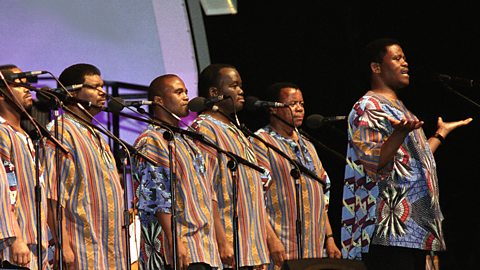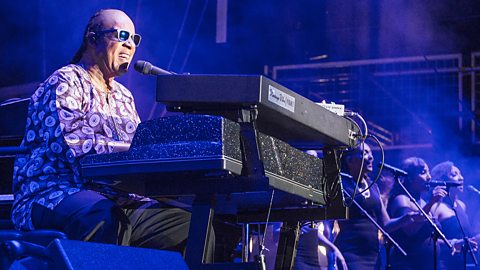Sonority - voices
There are many different forms of music composed for vocal performance.
Vocal range
Here are the main vocal ranges from highest to lowest.
| Voice | Description | Famous examples |
| Treble | A boyâs high unbroken voice - sometimes refers to a boy soprano | Ernest Lough singing Hear My Prayer |
| Soprano | A high female voice | Renee Fleming, Maria Callas, Björk |
| Mezzo-soprano | A medium high female voice | Cecilia Bartoli, Katherine Jenkins, Beyoncé |
| Counter-tenor | Male alto or soprano, sometimes described as falsetto | Andreas Scholl, Justin Hawkins of The Darkness |
| Alto (contralto) | A high male or low female voice | Janet Baker, Kathleen Ferrier |
| Tenor | A high male voice | Pavarotti, Placido Domingo, Jeff Buckley |
| Baritone | A medium male voice | Bryn Terfel, Elvis Presley |
| Bass | The lowest male voice | Willard White, Paul Robeson, Barry White |
| Voice | Treble |
|---|---|
| Description | A boyâs high unbroken voice - sometimes refers to a boy soprano |
| Famous examples | Ernest Lough singing Hear My Prayer |
| Voice | Soprano |
|---|---|
| Description | A high female voice |
| Famous examples | Renee Fleming, Maria Callas, Björk |
| Voice | Mezzo-soprano |
|---|---|
| Description | A medium high female voice |
| Famous examples | Cecilia Bartoli, Katherine Jenkins, Beyoncé |
| Voice | Counter-tenor |
|---|---|
| Description | Male alto or soprano, sometimes described as falsetto |
| Famous examples | Andreas Scholl, Justin Hawkins of The Darkness |
| Voice | Alto (contralto) |
|---|---|
| Description | A high male or low female voice |
| Famous examples | Janet Baker, Kathleen Ferrier |
| Voice | Tenor |
|---|---|
| Description | A high male voice |
| Famous examples | Pavarotti, Placido Domingo, Jeff Buckley |
| Voice | Baritone |
|---|---|
| Description | A medium male voice |
| Famous examples | Bryn Terfel, Elvis Presley |
| Voice | Bass |
|---|---|
| Description | The lowest male voice |
| Famous examples | Willard White, Paul Robeson, Barry White |
Solos and ensembles
In classical music the soprano, alto, tenor and bass - SATB - choir is a key part of church music, madrigals and opera choruses.
Choral music
Different types of choir include mixed choirs - usually with parts for SATB - male voice choirs, female choirs and a cappella ensembles.

A cappella ensembles are unaccompanied choruses. Ladysmith Black Mambazo are an a cappella Zulu male voice choir from South Africa. African songs are usually either strophic - split up into verses - or in call-and-response form.
In call-and-response form the leader sings a line - the call - and is answered by a chorus - the response. The chorus usually stays the same while the soloist improvises. There is often overlapping between the leader and the chorus. The chorus part is usually homophonic â in block chords.

Listen to the call and response used in The Star and the Wiseman sung by Ladysmith Black Mambazo. Notice the homophonic response parts.
Solo song
Different types of solo song include lieder, arias, ballads and folk songs.
The solo voice has been used in arias, solo songs and popular songs in all kinds of styles.
Lieder
Lieder - pronounced leeder - are German art songs from the Romantic period - roughly the 19th century.
Arias
Arias are solo songs found in operas and oratorio.
An opera is a drama set to music, acted and sung by solo singers and accompanied by an orchestra.
One of the most famous operatic tenor arias is âNessun Dormaâ - No one shall sleep - from Pucciniâs opera Turandot. This impassioned lyrical aria famously ends on a high sustained B. The voice is accompanied by orchestra and choir.
An oratorio is a setting of religious words for solo singers, chorus and orchestra. Unlike an opera, an oratorio is not staged. Messiah, by Handel, is the most popular oratorio.
Da capo arias were common in the 18th century. A da capo aria is where the voice returns to the head of the score (da capo) and repeats the first section of the music. It was common for the soloist to add ornamentation when the first section was repeated.
Pop ballads

Ballads
- Are slow, often sentimental, love songs.
- Sometimes tell a story.
- Are usually in verse-chorus form.
- Emphasise melody and lyrics - the accompaniment is often secondary.
- Are often accompanied on guitar or keyboard.
- Are found in many styles of pop music.
Some famous ballad singers are Frank Sinatra, eg My Way, Elvis Presley, eg Always on my Mind and Stevie Wonder, eg My Cherie Amour.
Folk song
British and American folk songs:
- often have a simple strummed guitar accompaniment
- are sometimes unaccompanied
- are usually in verse form - strophic
- sometimes, but not always, have choruses
- emphasise lyrics that often tell a story and sometimes have a political message
- place secondary importance on the accompaniment, with simple harmony and strummed chords
Examples of well-known folk songs are The Foggy Dew, She Moved Through the Fair and Freight Train â English, Irish and American respectively.
Vocal techniques
Different techniques are used to change the nature of the voice.
Vibrato
Vibrato is the pitch of the voice rapidly changing up and down. It gives notes warmth and richness. This technique is used a lot by opera singers.
Falsetto
When a male singer sings in the soprano or alto range he is singing falsetto. The voice type is known as countertenor.
Belting
Belting is when a singer uses their chest voice and pushes out the sound, often found in popular music and jazz. The effect can sometimes sound like shouting if not performed effectively.
Scat
Scat singing is a type of vocal improvisation using wordless or nonsense syllables. Ella Fitzgerald was known as a scat singer.
Rap
Rap is when an artist speaks words rhythmically and quickly over an instrumental or electronic backing.
Beatboxing
This is when a voice imitates the sounds of a drum machine. Beatboxing is popular in hip-hop music.